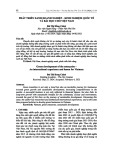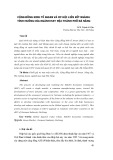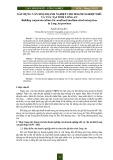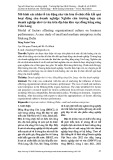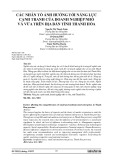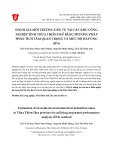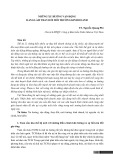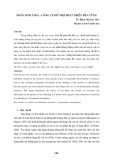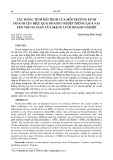
Chinese Business Gains Foothold in Eastern Europe
BUDAPEST — The classroom walls at the Hungarian-Chinese bilingual primary school
here are decorated with Chinese calendars and banners. Chinese lanterns hang from the
ceilings of the main entrance hall. There are stacks of new Chinese language books in the
staff room, provided by the Chinese authorities, who also send two teachers a year,
depending on the school’s needs.
The school cafeteria, however, serves only local fare. “No Chinese food, at least not yet,”
said Viktoria Schaff, one of the teachers.
Which is probably just as well, because the makeup of the state-financed school, the only
one of its kind anywhere in Eastern Europe, has changed a lot since it opened in 2004 in
response to the growing numbers of Chinese working in Hungary and the rising number
of Chinese companies investing in the region.
The first year, there were 86 pupils, all from China or other Asian countries. Of the 229
students who started this month, 90 are Hungarian.
“More and more Hungarian parents are sending their children here,” Ms. Schaff said.
“Their parents see the huge opportunities opening up for them as China becomes more
and more important.”
Education is not the only area in which China is making inroads in Central and Eastern
Europe. From the Baltic states to the Balkans, Chinese companies, flush with money, are
buying real estate and competing for public infrastructure contracts, especially as Poland
and Ukraine work at breakneck speed to jointly host the 2012 European soccer
championship.
They also are investing in manufacturing of products like electronics and chemicals to
gain a foothold inside Europe’s expansive single market.
In Poland last year, a Chinese consortium won the contract to construct two sections of a
highway from Lodz to Warsaw. It was not a huge deal, but it was the first time that a
non-Polish or non-European company was awarded a contract that will be partly financed
by the European Union.
“Some Polish companies were not happy,” said Henryka Bochniarz, president of the
Polish Confederation of Private Employers. “They said the Chinese were subsidized by
the Chinese government. But frankly, as long as they meet the procurement rules, you
can’t exclude them.”
Ms. Bochniarz added that the Chinese companies also hired Polish workers and
engineers. Indeed, Chinese companies are becoming increasingly active in Poland, where

the work force is well educated and still relatively inexpensive compared with Western
Europe.
Trade flows have also changed. “China used to mainly export textiles, shoes and tea to
Poland,” said Tomasz Ostaszewicz, director of the bilateral economic cooperation
department at the Polish Economy Ministry. “Now China is our main supplier of
electronic goods.”
As recently as 2007, Chinese investment in Poland, and across Eastern Europe as well,
was insignificant.
“Chinese investments in Poland amounted to €70 million in 2007,” or about $92 million
at current exchange rates, Mr. Ostaszewicz said. “The envisaged amount of Chinese
investment for 2010 could amount to €500 million.” That, he added, would create 3,230
new jobs.
The investments, which usually take the form of joint ventures, are spread across
manufacturing sectors, from electronics and machinery to packaging, plastics and paper
production.
In Hungary, the Wanhua Industrial Group recently acquired a strategic stake in
BorsodChem, a leading polyurethane producer in Central and Eastern Europe.
Wanhua, which is based in the northeastern city of Yantai, between Beijing and
Shanghai, is the largest producer in the Asia-Pacific region of isocyanates, a polyurethane
raw material used by the construction and automobile industry as well as for making
household appliances and footwear.
The company sells to the United States and Middle East markets, and was looking for a
presence in Europe, said Howard Ding, deputy general manager of Wanhua.
“BorsodChem gives us a manufacturing base in Europe,” he said. “It means better access
to the European market and better means to serve our customers.”
BorsodChem’s headquarters is in Kazincbarcika, a town in northeastern Hungary that
was built in 1949 as a local center for the newly created fertilizer and chemical
production sector. It was privatized in 1991, sold shares to the public five years later and
was bought out in 2006 by two private equity funds, Permira and Vienna Capital
Partners, which began to restructure the company.
They then started looking for investors to help pay for the construction of a new plant and
to provide much needed capital for a company that is highly leveraged. It has loans
totaling close to €1 billion.
In June, Wanhua provided €140 million to complete the construction of a new isocyanate
plant. In exchange, Wanhua got a 38 percent stake in First Chemical, the holding

company for BorsodChem, and an option to purchase the remaining shares within the
next 24 months.
Wolfgang Büchele, the chief executive of BorsodChem, said that without Wanhua, the
company would have found it very difficult to grow.“We become a member of a group
with a global view compared to BorsodChem, which is a regional player,” Mr. Büchele
said. Wolfgang Büchele, the chief executive of BorsodChem, said that without Wanhua,
the company would have found it difficult to grow. “We become a member of a group
with a global view compared to BorsodChem, which is a regional player,” Mr. Büchele
said.
Chinese companies and the Chinese authorities are shopping around in other countries in
the region. Last year, China signed a memorandum of understanding to lend $1 billion to
Moldova, one of the poorest countries in Europe. China’s central bank agreed last year to
a three-year currency swap of $2.3 billion to Belarus.
Ma Changlin, economic and trade counselor at the Chinese embassy in Warsaw, said
China “is interested in using the region as a springboard to the rest of the European
Union.”
Countries like Hungary, eager for the business even before the global financial crisis sent
the economy into a tailspin, have gone to great lengths to make them feel welcome.
The bilingual school is close to the Asia Center, a huge new shopping mall and business
park catering to the needs of the growing Chinese community, which local officials
estimate at several thousand people.
Strabag, the giant European construction company, invested 200 million euros in the
complex, which covers 1.35 million square feet. It opened in 2003 and now has more
than 500 showrooms representing a dozen Asian countries.
A walk though the sparkling clean building reveals a variety of products on display,
including textiles, electronics, jewelry, furniture, crafts and accessories. Nearby is a
Trade Promotion Center to advance contacts between Western and Asian companies.
In Poland, by contrast, government and business are less engaged in reaching out to
Chinese investors, Mr. Ma said. “There is no strategic vision for investment,” he said in a
recent speech to the Polish Information and Foreign Investment Agency. He cited a lack
of knowledge on both sides, as well as cultural differences and, on top of everything, the
language barrier.
That is something the Hungarians are trying to overcome. At the Hungarian-Chinese
school, Eszter Felfoldi, 9, said she had already decided what she wanted to do when she
finished her studies. “I want to be an interpreter,” she said. “When I am taken to a
Chinese restaurant, I already can ask for some of the dishes in Chinese.”

Commonwealth Games bridge collapses, raises concerns
New Delhi, India (CNN) -- A pedestrian bridge under construction for next month's
Commonwealth Games here collapsed Tuesday, officials said, adding to concerns raised
about India's preparedness for the international sporting event.
At least 24 people were injured, three critically, said New Delhi police spokesman Rajan
Bhagat.
The bridge near Jawarharlal Nehru Stadium came down while workers were laying a
concrete slab, said Rakesh Mishra, engineer-in-chief for New Delhi's Public Works
Department.
Designed as a pathway from a parking area to the stadium, the bridge was scheduled for
completion this week. The games begin October 3.
"We are inquiring into it," said Mishra about the cause of the collapse. "It could be faulty
execution or a fault in the design."
The games, hosted for the first time by the Commonwealth's most populous nation, have
already been troubled by delays in construction projects and allegations of corruption.
Also Tuesday, Mike Hooper, chief executive officer of the Commonwealth Games
Federation, complained of the conditions inside the rooms where the athletes are
expected to live.
"Filth, excrement -- it really is disgusting in parts. And it really requires a professional,
deep clean throughout the entire complex," he said.
Monsoon rains have similarly compounded the woes, with a spike in cases of dengue
fever, water-logged streets and massive traffic snarls.
And this week, security concerns heightened after a shooting attack Sunday on a bus near
a New Delhi mosque injured two Taiwanese tourists. Police, however, downplayed the
assault as "local mischief," insisting the city is safe for visitors.
fghanistan helicopter crash kills nine US Nato troops
Nine members of the Nato-led International Security Assistance Force have died in a
helicopter crash in Zabul province, southern Afghanistan.
All nine were US soldiers, it was announced later. A Nato soldier, an Afghan soldier and
a US civilian were also injured, Isaf said.
The Taliban said it shot down the aircraft but Isaf said there had been no enemy fire in
the area.

Continue reading the main story
AFGHAN HELICOPTER CRASHES
At least 529 foreign troops have been killed so far this year in Afghanistan.
With more than three months to go, 2010 is already the deadliest year since the US-led
invasion in 2001, according to figures collated by the website iCasualties.
A spokesman for the governor of Zabul told AP news agency the helicopter came down
in the province's north-western Daychopan district.
Isaf did not give the exact location of Tuesday's incident.
"The cause of the crash is under investigation," it said. "There are no reports of enemy
fire in the area."
An Isaf spokesman told the AFP news agency an operation was underway to recover the
aircraft.
The three injured have been taken to an Isaf medical facility for treatment.
There were no reports of insurgent activity in the area, suggesting the helicopter was not
shot down, says the BBC's Ian Pannell in Kabul.
Taliban spokesman Zabiullah Mujahid said insurgents had shot down the helicopter, but
this could not be substantiated. The Taliban often exaggerates reports of its attacks on
foreign troops.
There are almost 150,000 foreign troops fighting the Taliban in Afghanistan, supporting
about 300,000 Afghan security forces.

